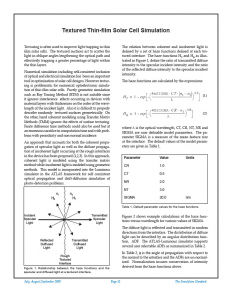Textured Thin-film Solar Cell Simulation
Texturing is often used to improve light trapping in thin film solar cells. The textured surfaces act to scatter the light in oblique angles lengthening the optical path and effectively trapping a greater percentage of light within the thin layers.
Numerical simulation including self-consistent inclusion of optical and electrical simulation has been an important tool in optimization of solar cell designs. However texturing is problematic for numerical optoelectronic simulation of thin film solar cells. Purely geometric simulation such as Ray Tracing Method (RTM) is not suitable since it ignores interference effects occurring in devices with material layers with thicknesses on the order of the wavelength of the incident light. Also it is difficult to properly describe randomly textured surfaces geometrically. On the other, hand coherent modeling using Transfer Matrix Methods (TMM) ignores the effects of surface texturing. Finite difference time methods could also be used but at an enormous sacrifice in computation time and with problems with periodicity and non-normal incidence.
An approach that accounts for both the coherent propagation of specular light as well as the diffuse propagation of incoherent light occurring at the rough interfaces in the device has been proposed (1,2,3). In this approach, coherent light is modeled using the transfer matrix method while incoherent light is modeled using geometric methods. This model is incorporated into the Luminous simulator in the ATLAS framework for self consistent optical propagation and drift-diffusion simulation of photo-detection problems.



